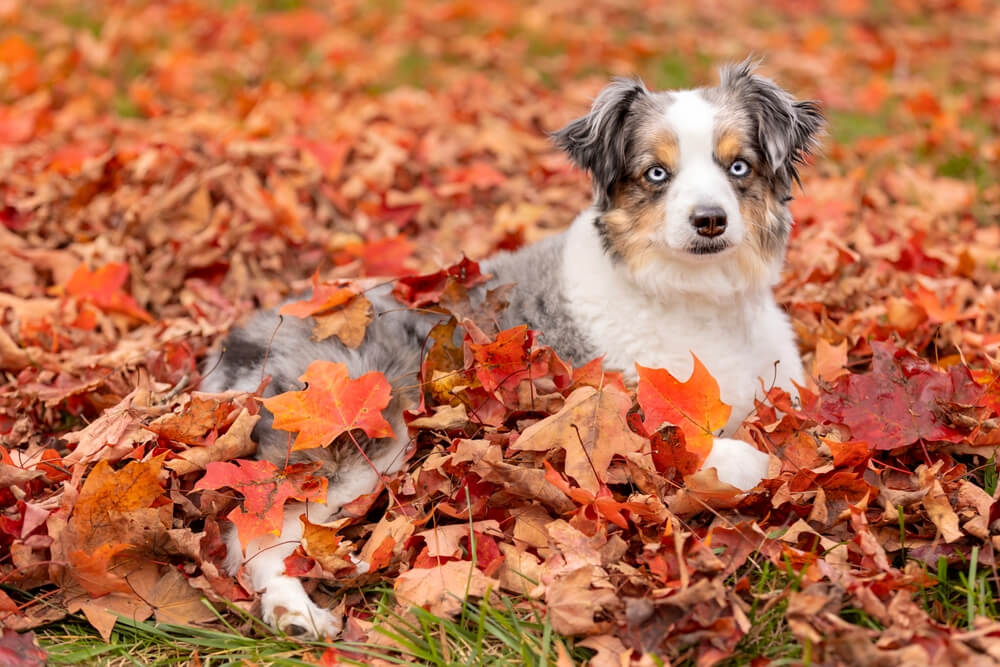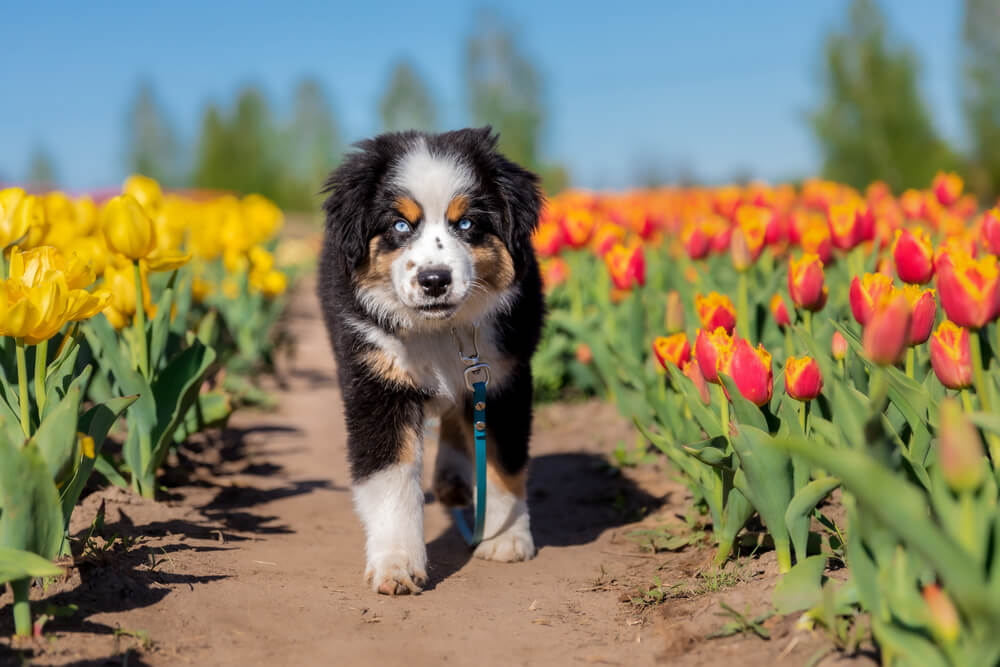
Adding a pet to your family is a big decision. Not only do you have to think about cost and responsibility, but you also have to consider the specific traits of a breed and if they’re suitable for your household.
Some people want an energetic and rugged dog to accompany them on their outdoor adventures; others want a small, friendly dog that’s great around children. Why not get the best of both worlds with a Mini Australian Shepherd?
In this guide, you’ll learn all about this versatile pup, including appearance, temperament, exercise needs, and more. So, let’s get started!
Miniature Australian Shepherd Overview
Mini Australian Shepherds are compact versions of Australian Shepherds. But don’t let their size fool you—every inch of them is just as willing and capable as their standard counterparts.
They’re true herding dogs, through and through. As such, they are highly active and intelligent. So, if you don’t have much time to spend giving them adequate exercise and mental stimulation, this may not be the breed for you.
However, if you and your family are highly active and enjoy spending time outdoors, Mini Aussies are an ideal companion.
Speaking of families, Miniature Australian Shepherds make excellent family dogs. They’re extremely affectionate pooches and are gentle with young children. Plus, they love other dogs, so if you already have a dog, you won’t have to worry much about aggression or jealousy from the Aussie.
They’re slightly aloof when it comes to strangers, but if you’re thinking of making a watchdog out of your Mini Aussie, think again.
While protective, they’re no match for a true watchdog, like a German Shepherd or Rottweiler. They’re also only moderately vocal; they’re more likely to bark while herding than a possible threat.
If all this sounds good to you, then a Miniature Aussie Shepherd might be the dog for you! But let’s dive deeper into this breed’s history, characteristics, and needs before you run out to adopt one.
History of the Mini Australian Shepherd
In the 1960s, breeders began to breed small-sized Standard Australian Shepherds to get Miniature Australian Shepherds. By the mid-1970s, breeders had gotten Minis to the ideal size.
The Miniature Australian Shepherd breed is often abbreviated to MAS, and AKC breeders of Mini Aussies are known as the MASCUSA. However, the “A” in MAS doesn’t stand for Australian, but American.
In 1993, the AKC approached the MASCUSA and asked them to change their name because it was too similar to the AKC’s affiliated breed, the Australian Shepherd. So, the MASCUSA changed its name to the North American Miniature Australian Shepherd Club of America (NAMASCUSA).
By 2011, due to some controversy over Mini Australian Shepherds not being recognized by the AKC, the breed’s name changed to Miniature American Shepherd. And by 2015, the breed became recognized by the AKC. Though, this decision is still hotly debated in the Mini Aussie Shepherd community.
Characteristics of the Mini Australian Shepherd
Below is a rundown of the common characteristics found in Miniature Australian Shepherds.
Breed Appearance
The Mini Aussie Shepherd has a long double coat that can come in a variety of colors:
- Black
- Red
- Red Merle
- Blue Merle
All of these coats have a further qualifier, in that any can be bicolored or tricolored. If bicolored, the coat will have white trim, and if tricolored, it will have white trim and tan highlights.
Male Mini Aussies stand between 14 and 18 inches tall, while females are 13 to 17. Both genders will weigh between 20 and 40 pounds when fully grown.
Temperament & Personality
The best word to describe a Mini Australian Shepherd is “workaholic.” They’re at their happiest when they have something to do. Conversely, when they get bored, they become irritable and destructive. So, it’s in your best interest and your pup’s to keep them busy.
They are quiet dogs unless something is upsetting them. Excessive barking could mean they are alarmed or under-stimulated.
Though they are good with other dogs, other pets, like cats, may not get along well with Mini Aussies. This is because they were born to herd, so they will attempt to herd smaller animals.
As stated, Mini Aussies are great family pets. In fact, they do better in families compared to living with a solo person. They love to play rough and tumble, so they’re well-suited for young children who may not be very gentle with animals yet. Plus, their boundless energy will keep children entertained for hours.
Living Needs
Mini Aussies are versatile, so they can live in an apartment if they’re sufficiently exercised. Having a yard would be best if you don’t have enough time to go out with your Mini multiple times a day. Of course, if you live on a property with many acres, such as a farm, the pup will thrive.

Due to their double coat, they can become quickly overheated in hot climates. So, keep an eye out for excessive panting or signs of heat exhaustion on hot days.
On the other hand, if you live in a cooler climate, you won’t have to worry too much about your Mini Aussie getting too cold—their wooly undercoats offer more than enough protection from frigid temperatures.
Life Expectancy
One might think that because of their smaller size, they have a longer lifespan than Standard Aussies. However, this is not true. Standard Australian Shepherds live approximately 13 to 15 years, while Minis live 12 to 13 years on average.
Mini Australian Shepherd Care
Like all dog breeds, there are specific needs and health conditions that owners should be knowledgeable about to keep their pups in optimal health. Below are some factors to consider before adopting a Miniature Australian Shepherd.
Training & Exercise Needs
One of the iconic features of the Miniature Australian Shepherd is its seemingly endless amount of energy. With that, they require more exercise than the average dog.
At a minimum, they need at least one hour of spirited daily exercise. Running, hiking, or a game of fetch will be sufficient to tire your pup out. If you’re interested in more structured exercise, Mini Aussies excel at agility, flyball, and tracking.
This breed is also extremely intelligent and requires mental stimulation to keep them from growing bored. They’re quick to pick up new tricks and general obedience skills, which will also help them to be the best possible companion.
However, their intelligence has a drawback, as it makes them little sponges. So you must be careful what you teach them, even if it’s inadvertent. For instance, if you slip them a treat or two off your plate, they won’t soon forget, and you’ll have to deal with pleading (though adorable) eyes every time you sit at the dinner table.
Because of their alert and cautious nature, early socialization with humans and dogs is necessary. This will ensure your Mini Aussie does not grow to be aggressive with or frightened by new people and other pups.
Grooming
Mini Aussie’s double coats don’t require any professional grooming. However, it’s recommended that you brush them weekly to keep their coats healthy and to reduce shedding.
When it’s shedding season, which occurs once or twice a year depending on the climate in which you live, you should brush them daily.
All dogs require routine nail trimming to avoid discomfort or possible injuries to you or your pet caused by long nails. So, keep an eye on their paws and get them used to nail grooming early on so that you don’t have regular struggles when trimming their nails.
Health
Mini Australian Shepherds are generally a healthy breed with few known issues. Among the common problems you may run into are:
- Eye issues, particularly progressive retinal atrophy
- Drug sensitivity due to MDR1 gene mutation
- Hip dysplasia
Regular vet checkups are necessary for early detection or even prevention of these conditions.
Diet and Nutrition
Miniature Australian Shepherds require a nutritious, age-appropriate diet, as with all breeds. The general rule of thumb for 20- to 40-pound dogs is 1 ½ to 2 ½ cups of food daily. Of course, this depends on a few factors:
- Type of food
- Weight
- Metabolic rate
- Amount of exercise
If your Mini Aussie gets a ton of exercise, they’ll need more food. However, if you have them on a raw food diet or a high-calorie kibble for active dogs, this will also change the required amount of food.
It’s always best to check with your vet, who can recommend the best type of food and ideal amount your specific pup requires to keep them healthy.
FAQs
Here are a few common questions about Miniature Australian Shepherds.
Do all Miniature Australian Shepherds have colorful eyes?
No, not all Mini Aussies have colorful eyes. However, it’s common for them to have eye colors different from the standard brown in most breeds. In addition, some Mini Aussies will have two different colored eyes or exhibit different colors within the same eye, known as heterochromia.
Mini Aussies can have a combination of any of the following colors:
– Brown
– Blue
– Hazel
– Amber
– Green
Do Mini Australian Shepherds shed a lot?
You’d think so. However, despite Mini Aussie’s long double coats, they don’t shed all that much and only require semi-frequent grooming. This means you won’t be pulling out your vacuum daily.
That said, you should expect your Mini Aussie to shed a moderate amount of hair year-round. Then, in the spring and fall, they shed quite a bit as their coats will change to acclimate to warmer and cooler weather.
How much does a Miniature Australian Shepherd cost?
Mini Aussies cost a bit more than Standards. You can expect to pay between $1,000 and $3,000 for a Miniature Australian Shepherd puppy from a reputable breeder. However, some pups can go for as much as $5,000.
The price gap is so wide because of the vast range of coats and eye colors found in Mini Aussies. Merle- and red-coated Minis are generally the most expensive, as they are the rarest. Also, Merles often have blue eyes, or at least one blue eye, a highly sought-after feature.
Conclusion
Now you know all the ins and outs of this energetic working breed. If the Miniature Australian Shepherd sounds like the right breed for you, you’ll be sure to have a loving and loyal companion for years to come.
As with all pets, keeping their well-being in mind is vital. So, before you adopt, ensure you have the time, energy, and money to keep your best friend happy and healthy.

